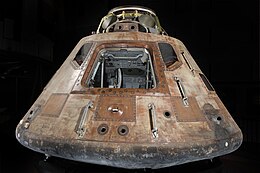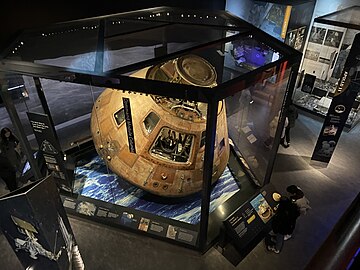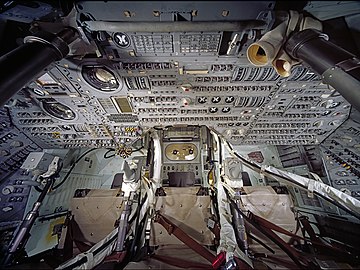| Columbia | |
|---|---|
| Part of Apollo 11 | |
 Columbia on display at the National Air Columbia on display at the National Airand Space Museum in Washington, D.C. | |
| Type | Reentry capsule |
| Manufacturer | North American Aviation |
 |
| Part of a series on |
| Apollo 11 |
|---|
|
Command module Columbia (CM-107) is the spacecraft that served as the command module during Apollo 11, which was the first mission to land humans on the Moon. Columbia is the only spacecraft of the 1969 Apollo 11 mission that returned to Earth.
Name
The name Columbia was first suggested to Michael Collins by Julian Scheer, NASA assistant administrator of public affairs during the Apollo program. Scheer mentioned the name, in passing, in a phone conversation, saying "some of us up here have been kicking around Columbia." Collins initially thought it was "a bit pompous" but the name eventually stuck as he could not think of a better alternative and his crewmates Buzz Aldrin and Neil Armstrong had no objections. Collins was also influenced to accept the name because of its similarity to Columbiad, the name of the space gun in Jules Verne's 1865 science fiction novel From the Earth to the Moon.
Post mission history
Following the mission and after a tour of U.S. cities, Columbia was given to the Smithsonian Institution in 1971. It was designated a "Milestone in Flight" and displayed prominently at National Air and Space Museum in Washington, D.C., alongside the 1903 Wright Flyer.
In July 2016, the Smithsonian released a 3D scan of Columbia produced by the Smithsonian's Digitization Program Office. During the scanning process a number of places where the astronauts had written on the walls of the capsule were found. These included a calendar and a warning about smelly waste on one of the lockers.
In 2019, to commemorate the 50th anniversary of the Apollo 11 landing, the spacecraft traveled around the country on a tour to museums in Houston, St. Louis, Pittsburgh, Seattle, and Cincinnati.
In 2022, Columbia was taken off display as a part of the National Air and Space Museum's renovation. When the museum reopened in the fall of 2022 it became a centerpiece of their new Destination Moon exhibit.
-
 Columbia Module in its new exhibit on display at the Air and Space Museum in Washington D.C.
Columbia Module in its new exhibit on display at the Air and Space Museum in Washington D.C.
-
 Interior of the Command module
Interior of the Command module
See also
References
- ^ National Air and Space Museum (March 20, 2016). "Apollo 11 Command Module Columbia". Smithsonian Institution. Archived from the original on July 20, 2019. Retrieved September 24, 2019.
- Craddock, R. A. (2003). Apollo 11 Box: Artifacts from the First Moon Landing. Chronicle Books. p. 57. ISBN 978-0-8118-3734-7.
- Collins, Michael (2001). Carrying the Fire: An Astronaut's Journey. Rowman & Littlefield. pp. 334–335. ISBN 978-0-8154-1028-7.
- Lindsay, Hamish (2001). Tracking Apollo to the Moon. Springer. p. 24. ISBN 978-1-85233-212-9.
- Collins (2001), p. 335.
- ^ McEwan, Liz (September 24, 2019). "To the moon (and Cincinnati) and back". Soapbox Cincinnati. Retrieved September 24, 2019.
- Craddock (2003), p. 2.
- van der Linden, F. Robert (2016). Best of the National Air and Space Museum. Smithsonian Institution. p. 3. ISBN 978-1-58834-581-3.
- ^ Pearlman, Robert Z. (February 12, 2016). "Apollo 11 Crew Wrote on Moon Ship Walls, Smithsonian 3D Scan Reveals". Space.com. Retrieved March 9, 2020.
- Weiner, Sophie (July 22, 2016). "Take a 3D Tour Inside the Apollo 11 Command Module". Popular Mechanics. Retrieved March 9, 2020.
- "Destination Moon". August 11, 2020.
Further reading
- Brooks, Courtney G.; Grimwood, James M.; Swenson, Loyd S. (1979). Chariots for Apollo: The NASA History of Manned Lunar Spacecraft to 1979 (PDF). NASA.
| Apollo program | |||||||||||
|---|---|---|---|---|---|---|---|---|---|---|---|
| Launch complexes |  | ||||||||||
| Ground facilities | |||||||||||
| Launch vehicles | |||||||||||
| Spacecraft and rover | |||||||||||
| Flights |
| ||||||||||
| Apollo 8 specific | |||||||||||
| Apollo 11 specific | |||||||||||
| Apollo 12 specific | |||||||||||
| Apollo 13 specific | |||||||||||
| Apollo 14 specific | |||||||||||
| Apollo 15 specific | |||||||||||
| Apollo 16 specific | |||||||||||
| Apollo 17 specific | |||||||||||
| Post-Apollo capsule use | |||||||||||
| Related | |||||||||||
| |||||||||||
| Apollo program hardware | |
|---|---|
| Launch vehicles | |
| Launch vehicle components | |
| Spacecraft | |
| Spacecraft components | |
| Space suits | |
| Lunar surface equipment |
|
| Ground support | |
| Ceremonial | |
| Related | |
- Apollo 11
- Spacecraft which reentered in 1969
- Individual space vehicles
- Buzz Aldrin
- Neil Armstrong
- Michael Collins (astronaut)
- Crewed spacecraft
- Apollo program hardware
- Spacecraft launched by Saturn rockets
- Spacecraft that orbited the Moon
- Individual spacecraft in the Smithsonian Institution
- Spacecraft launched in 1969